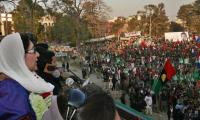Despite having one constitution and a single currency, Pakistan’s human development landscape is horrifically unequal. The country is politically divided into four provinces, Fata, Islamabad, and two disputed regions – Azad Kashmir and Gilgit-Baltistan. There are no physical barriers, like walls or fences, between these political entities.
The striking differences among areas in Pakistan are not rooted in history. In fact they did not even exist prior to Partition. For example in 1947 Pakistan hardly had an industrial base. But government incentives and initiatives benefited the elite and those regions that were close to the political power.
Pakistan’s first ever Multidimensional Poverty Index (MPI), launched in June 2016, highlighted these stark socio-economic variances in red and green. Punjab’s central and northern districts are in green, indicating less than 10 percent poverty. In stark contrast, resource-rich Balochistan and Fata are highlighted in red, pointing towards the alarming over 70 percent multidimensional poverty.
MPI further confirms that progress across different regions of the country is uneven. For example, poverty in urban areas is 9.3 percent as compared to 54.6 percent in rural areas.
Disparities also exist across the provinces. The report states that over two-thirds of the people in Fata (73 percent) and Balochistan (71 percent) live in multidimensional poverty. Poverty in Khyber Pakhtunkhwa stands at 49 percent, Gilgit-Baltistan and Sindh at 43 percent, Punjab at 31 percent and Azad Jammu and Kashmir at 25 percent. Islamabad, Attock, Jhelum, Lahore, Karachi and Rawalpindi have been declared the best performing districts in reducing poverty.
The Asian Development Bank Country Partnership Strategy report for 2015-2019 also authenticates that large variations exist in poverty trends across the four provinces. For instance, headcount poverty for Punjab in 2006 (15.2 percent) was significantly below that in Balochistan (50.9 percent), with intermediate rates in Khyber Pakhtunkhwa (28.2 percent) and Sindh (22.7 percent).
Furthermore, the World Bank, the UNDP’s Human Development Indicators and countless national and international research and findings depict a very grim reality prevailing in Balochistan, Fata, southern Punjab and rural Sindh.
This uneven social and economic landscape didn’t emerge overnight. It is a result of a persistent policy of discrimination, flawed social engineering and lack of transparency and democratic values. These factors hit marginalised communities and regions the hardest.
All available facts indicate that the Pakistani elite has been more focused on larger constituencies for support. East Pakistan was ignored in the early years. From the very beginning it was a planned policy of asset concentration; and apparently 22 families of selected regions were controlling 66 percent of Pakistan’s industrial wealth.
Even in the post-1971 scenario, after the secession of East Pakistan, these policies continued. For instance, uneven agriculture credit distribution has been going on since the 1960s without a single effort having been made to address this alarming discrimination which hinders millions of farmers in Balochistan and Sindh from accessing agriculture loans.
A 2015 report of the State Bank of Pakistan stated that “In FY13 and FY14, banks exceeded their indicative agricultural lending target in Punjab, but they failed to meet the targets set for the three other provinces and two separate administrative divisions.”
The lending to Punjab’s agriculture sector by banks totalled Rs293.3 billion and Rs339.1 billion in FY13 and FY14, against the targets of Rs246 billion and Rs294.7 billion respectively.
In FY13 and FY14, Punjab got 87.2 percent and 86.6 percent of total agricultural financing, leaving just 12.8 percent and 13.4 percent for the rest of the country. In reality, Punjab’s share in the agricultural economy is to be no more than 60 percent.
But the fact still is that farmers of Sindh, Khyber Pakhtunkhwa, Balochistan, Azad Jammu and Kashmir (AJK) and Gilgit-Baltistan (GB) received lesser-than-targeted agricultural loans.
Since development loans for the farming sector are often used to purchase tractors, tube wells, trolleys, power generators, wheat thrashers, grain separators and other equipment and machinery, low lending for development effectively impedes farm mechanisation. And that, in turn, makes it difficult to enhance per-acre yields of crops.
Poverty and underdevelopment are not a choice or a culturally or religiously embedded part of the impoverished regions. In fact, lack of representation – both in military and civilian institutions – lack of the right policies, incentives, sincere attention and continuity have created Somalia-like pockets in each and every corner of Pakistan.
The central and northern parts of Punjab are developed, which is credited for the access to power, both civilian and military. This, in turn, creates incentives and provides easy access to resources, decision-making and economic institutions. As a result, these state-backed policies and incentives enable Punjab’s central and northern regions to develop uninterruptedly.
Punjab also has access to more democratic institutions compared to Balochistan and Fata where political decisions are made through the interference of the central government and the military. People choose their representatives freely, without any meddling by the security agencies. In consequence, politicians and the military leadership focus on services ranging from health, roads, gas supply, access to clean drinking water, agriculture inputs, loans and best education facilities.
Pakistan’s poverty-hit provinces and regions like Balochistan and Fata live in a different world, a world shaped by different strategic priorities, institutions and policies – which do not favour social development. All one can see are security-centric policies and priorities.
Despite Gen Musharraf-era mega projects, military operations, and adventurous policies opted in Balochistan and Fata, poverty, regional disparity and inequality stand tall and strong in most parts of these regions.
Unfortunately, there are no sustainable policies, interventions and strategies being adopted to address the ever-growing inequalities in these areas.
Insecurity is highlighted as a cause of slowdown in social and economic growth in the country’s poverty-stricken regions. However, no peaceful solution has been proposed or encouraged by the security establishment to pacify and resolve conflicts triggered by socio-economic inequalities and realities.
Factors such as poverty, inaccessibility to social and economic incentives, lack of short and long-term interventions and flawed and discriminatory regimes in all spheres of state affairs have created a divided society with a wounded landscape where millions live on an empty stomach as the remaining population has access to the state system, to power, employment and opportunities of their choice.
The writer is a former senator from Balochistan.
Email: balochbnp@gmail.com
When she left venue after addressing rally, large of people came out onto streets to catch glimpse of their great...
Anniversary of her death is not just moment to mourn but time to reflect on what Pakistan lost
This production could reduce carbon emissions by 70-80 per cent compared to conventional jet fuels
She chose to give her life, leaving behind legacy of incredible struggle for democracy
A Pakistani man rests under the shade of trees during a heatwave in Karachi, Pakistan, on June 23, 2015. — AFP The...
Ms Benazir Bhutto had returned to Pakistan with mission of reconciliation in politically and religiously divided country







